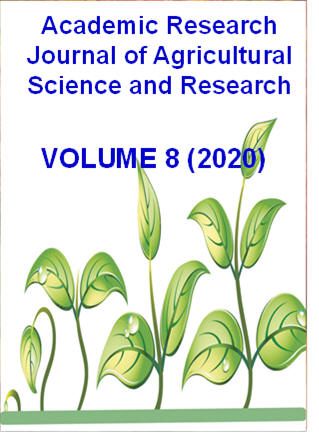|
ISSN: 2360-7874 |
Academic Research Journal of
Agricultural Science and Research |
|||||||||||||||||||
|
Vol. 8(2), pp. 74-81, March 2020 Research Antibiotic Activity of Wild Melon [Adenopus Breviflorus Benth] Fruit
Ogunleye A.J. *1, Atteh, J.O.2 and Kolawole O.M.3
1Department of Agricultural Education, Kwara State College of Education, Oro, Nigeria 2 Department of Animal Production, University of Ilorin, Nigeria 3Department of Microbiology, Faculty of Life Sciences, University of Ilorin, Nigeria *Corresponding Author; E-mail: juliusogunleye60@gmail.com
Accepted 30 March 2020
Wild Melon [Adenopus breviflorus benth] (ADB) matured whole fruits, its epicarp, pulp, and seed were respectively extracted with methanol, ethanol, ethyl acetate and n-hexane. The activity of each extract was examined at 10% concentration on four strains of bacteria isolates from poultry faeces, viz Escherichia coli, Klebsiella pneumoniae, Salmonella typhi and Streptococci enterococcus; the synergistic effect of seed and pulp extract were also examined on the test organisms at 10% concentration. The whole fruit and epicarp extracts were both screened for Minimum Inhibitory Concentration (MIC) and Minimum Bacteriocidal Concentration (MBC) ranging from 0.7-10% concentration. The results revealed that whole fruit and epicarp extract inhibited the growth of Klebsiella pneumoniae and Salmonella typhi at 10% concentration while Streptococci enterococcus and Escherichia coli were resistant to the same extract at the same concentration. The pulp and seed extract did not show antibacterial activity on any of the test organisms at 10% concentration the synergistic effect of the pulp and seed extracts also displayed no activity. The MIC of whole fruit and epicarp extract was 0.9-3% and 0.8 – 0.9% respectively. The results revealed that MBC of whole fruit and epicarp extract was between 9-10% and 10% respectively. It was concluded that the whole fruit and epicarp of wild melon have some phytochemicals which may be absent in the pulp and seeds or if present is at a significantly low level. These phytochemicals makes the whole fruit and epicarp extract to be capable of inhibiting the growth and the control of Klebsiella pneumoniae and Salmonella typhi. Further investigation is therefore suggested for the examination, identification, and quantification of phytochemicals in parts of ADB fruit.
Key words: Wild melon fruits, Antibiotic activity.
How to cite this article (APA Style): Ogunleye A.J., Atteh, J.O., Kolawole O.M. (2019). Antibiotic Activity of Wild Melon [Adenopus Breviflorus Benth] Fruit. Acad. Res. J. Agri. Sci. Res. 8(2): 74-81
|
|||||||||||||||||||
